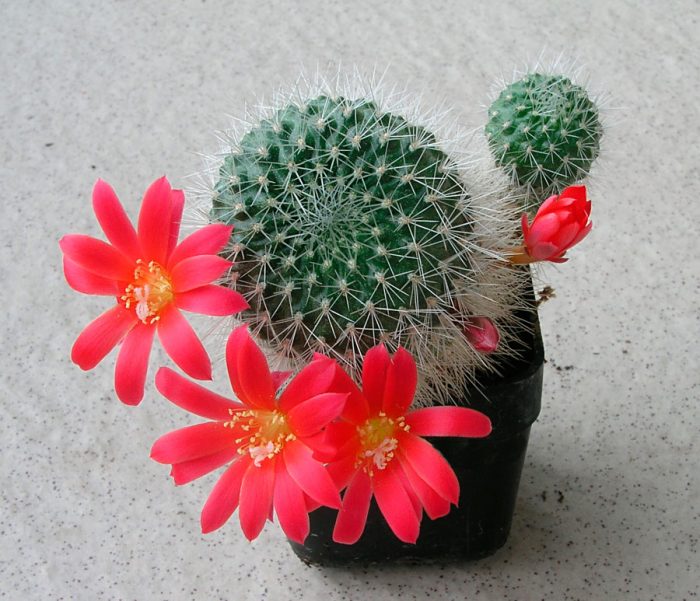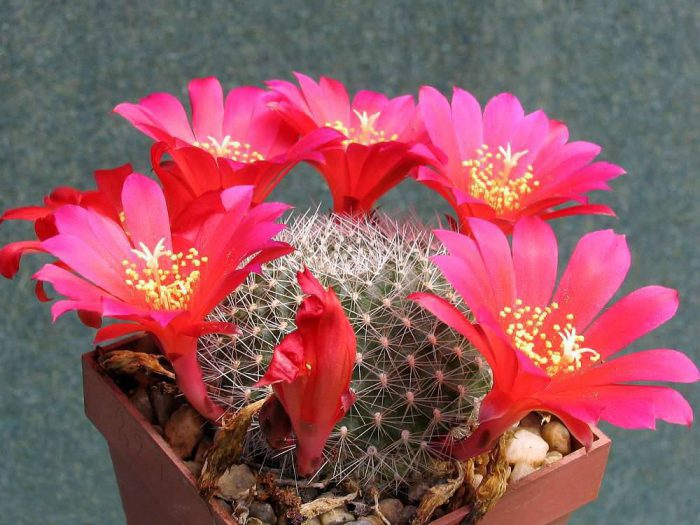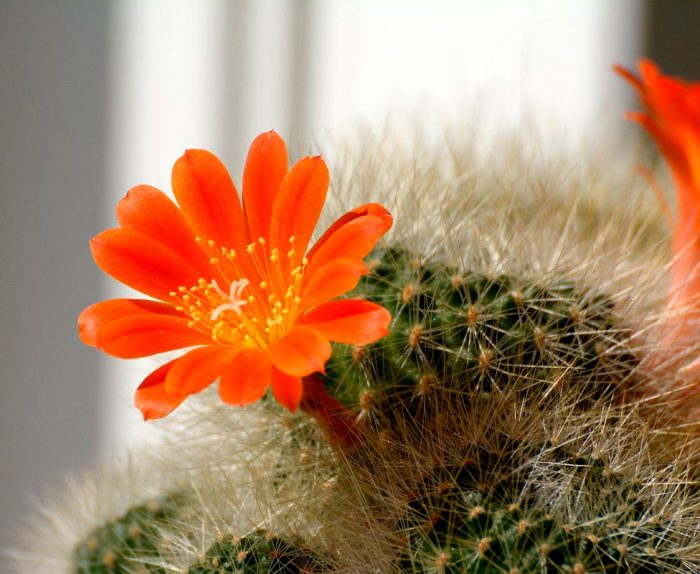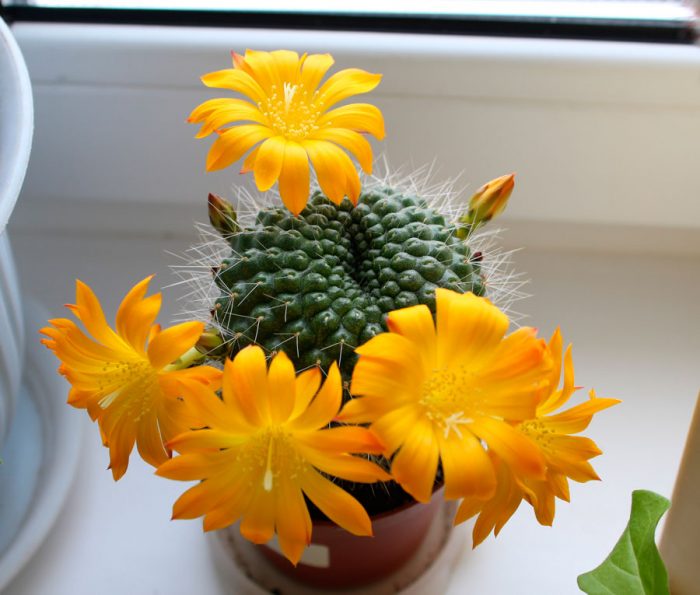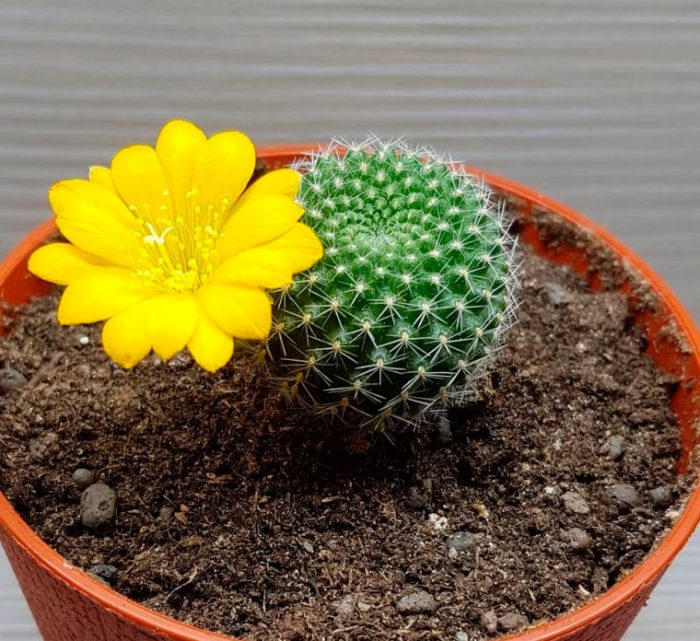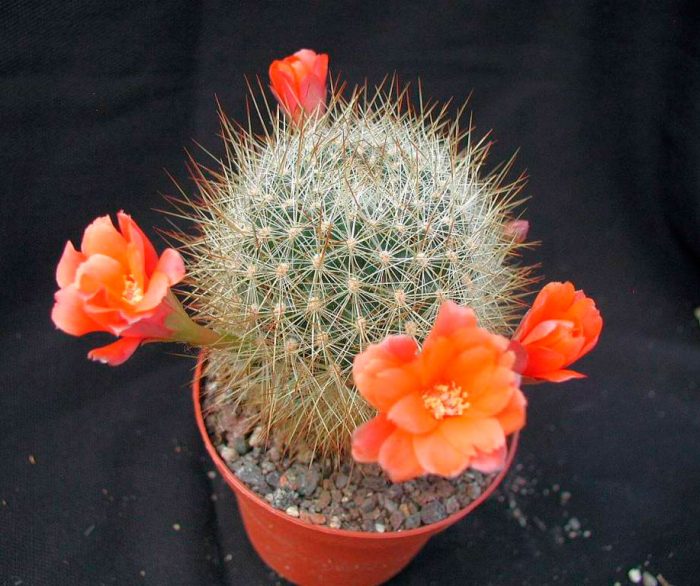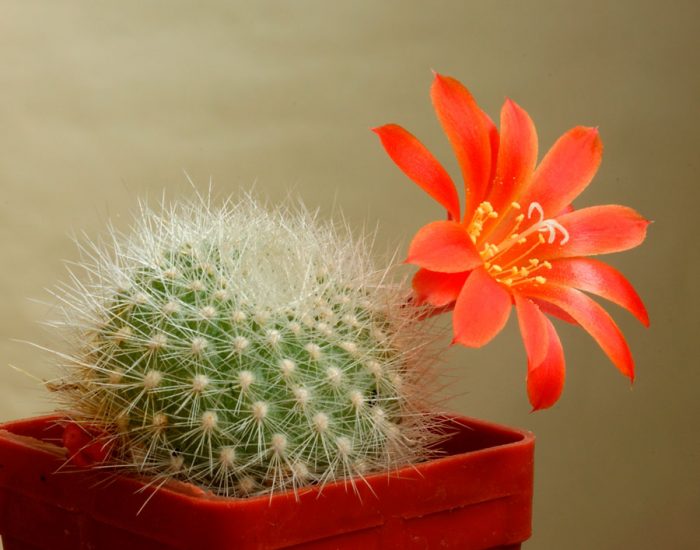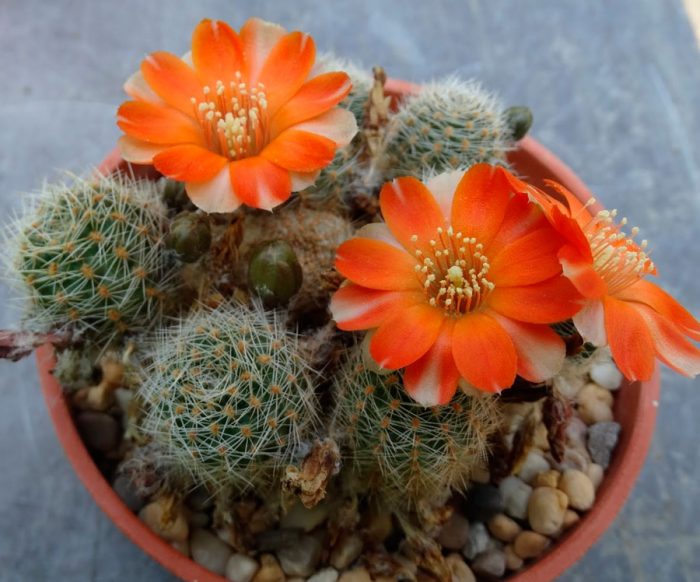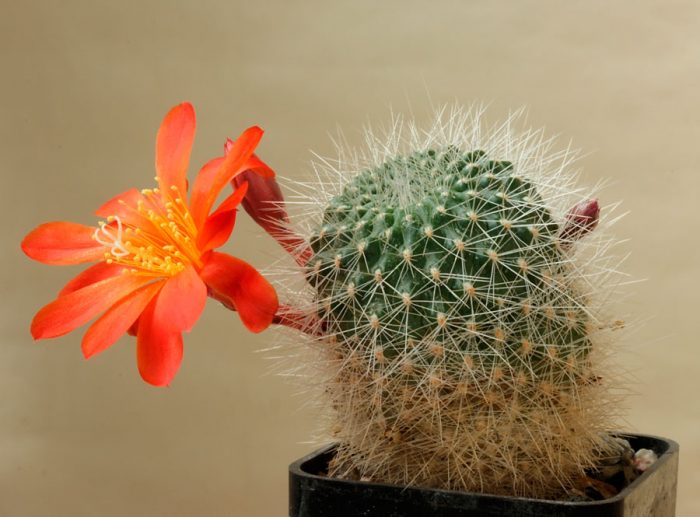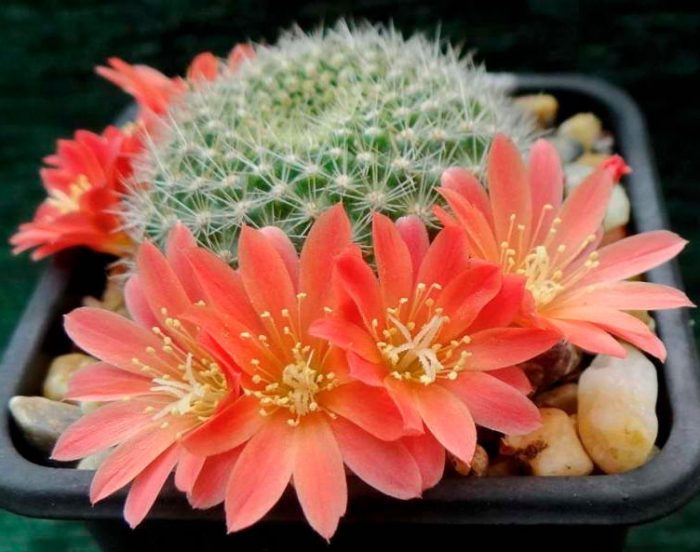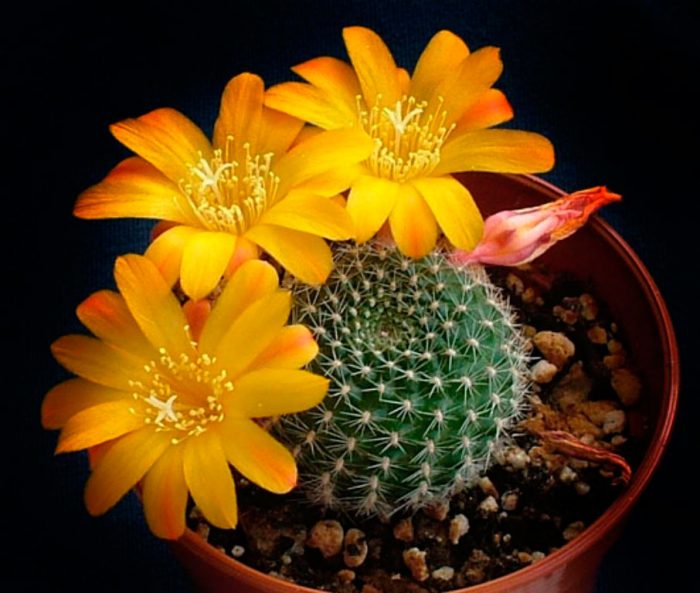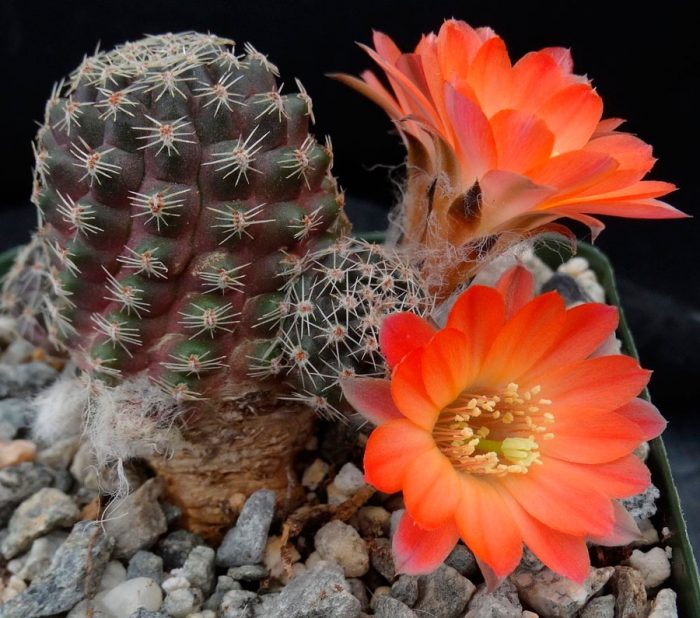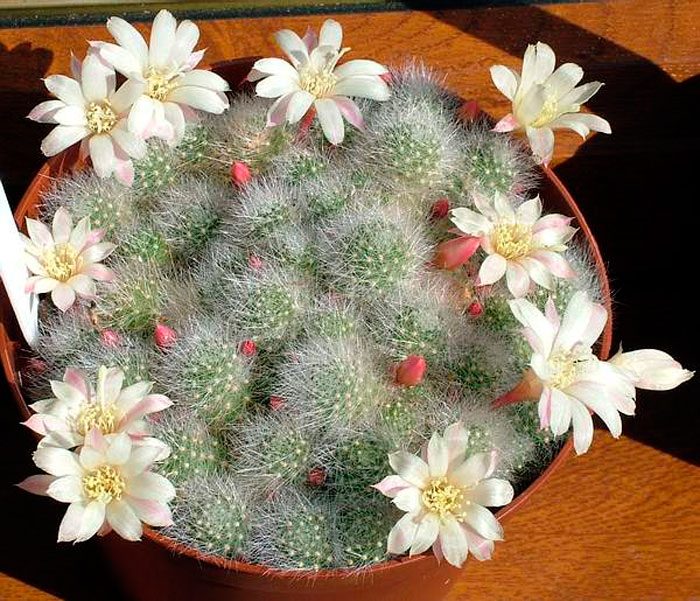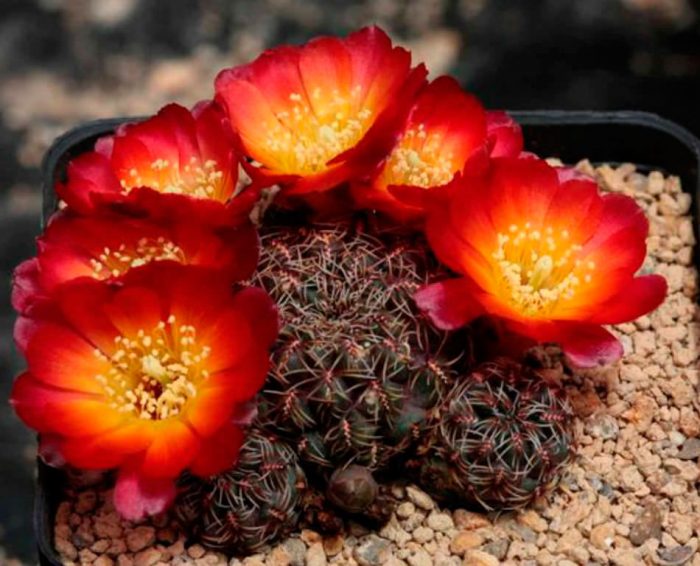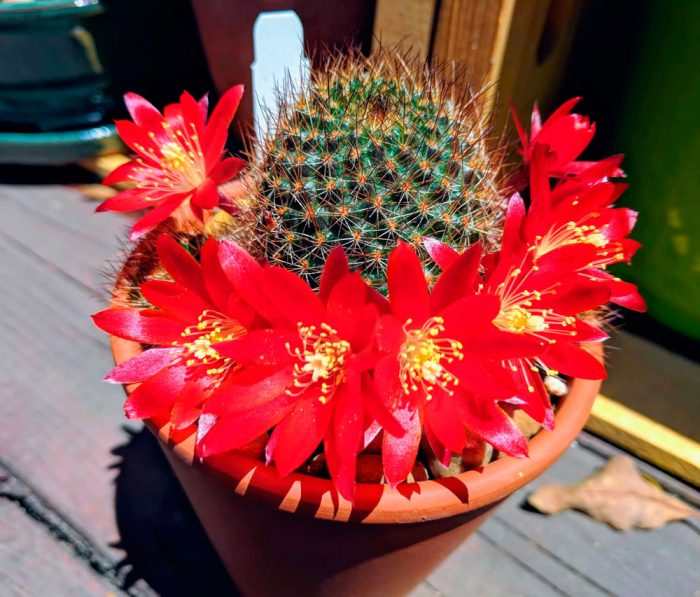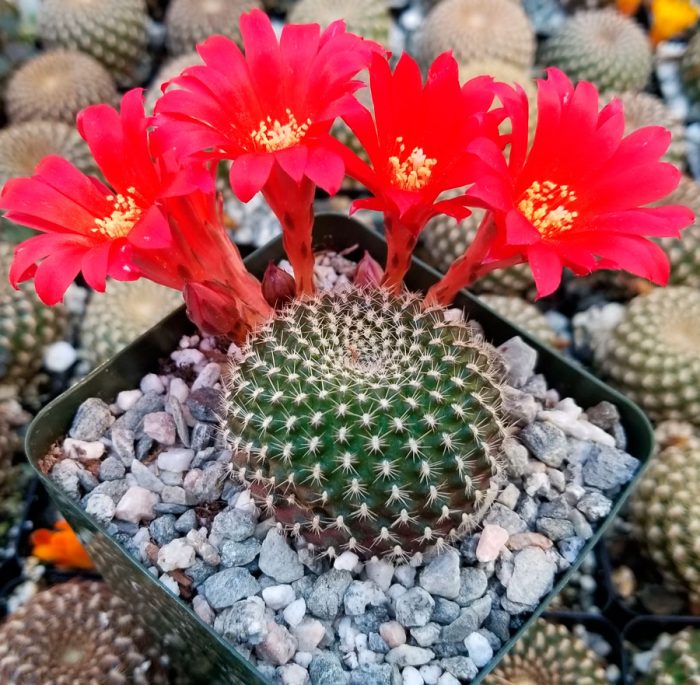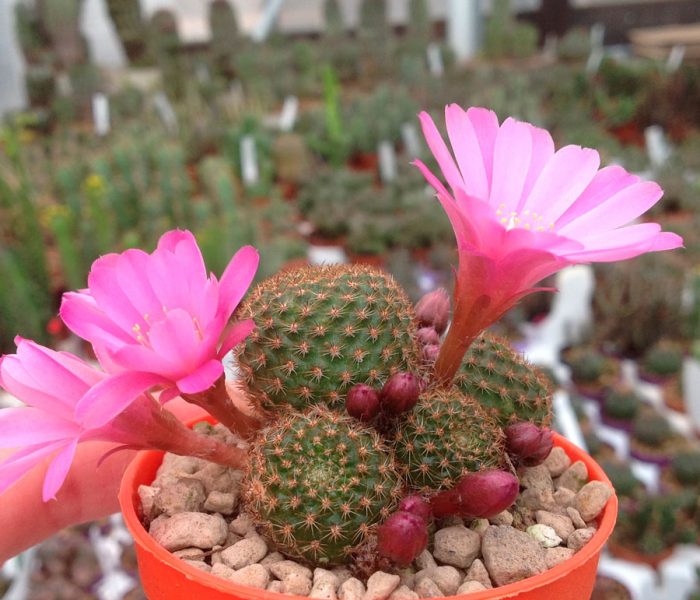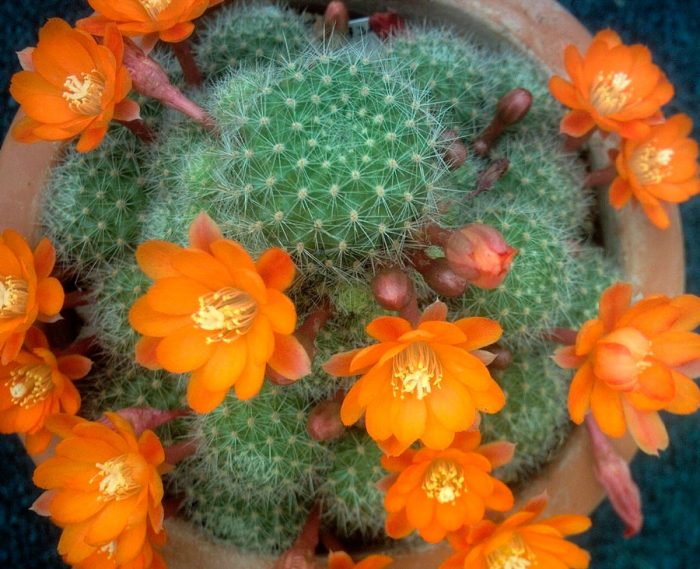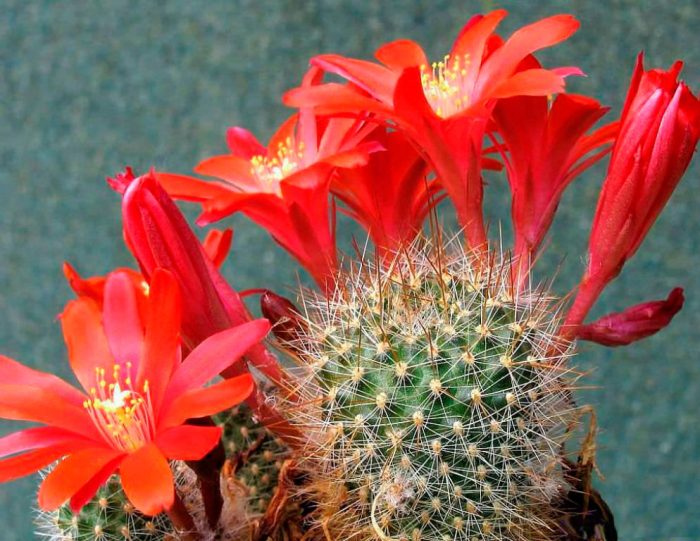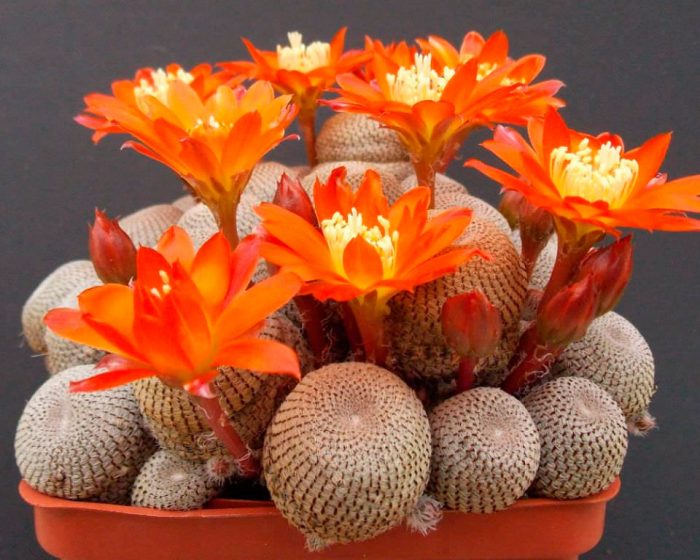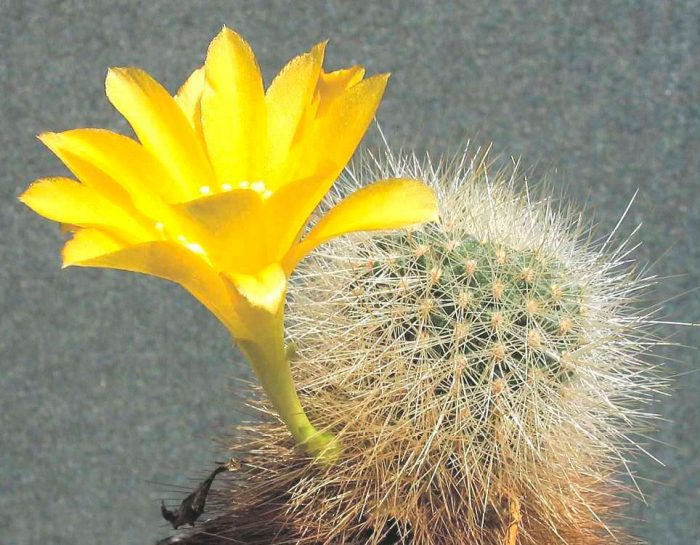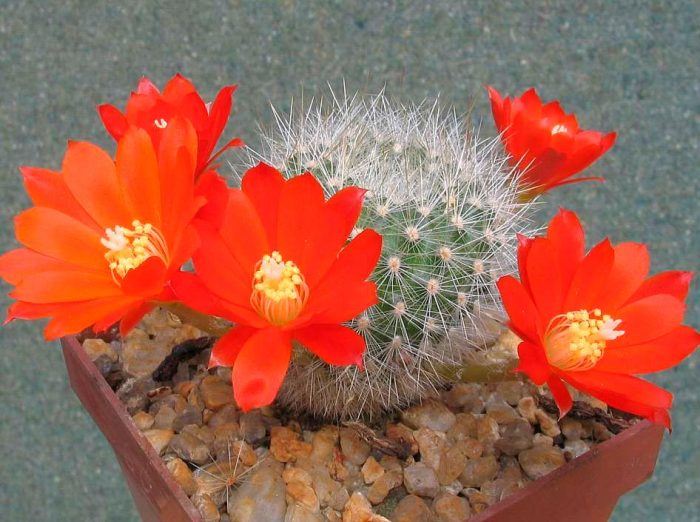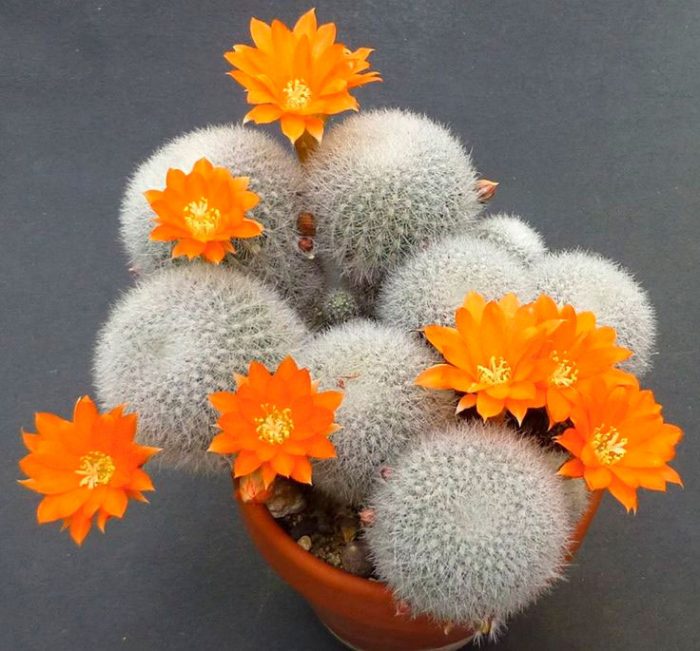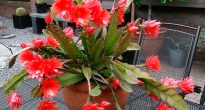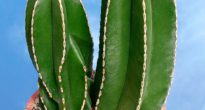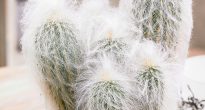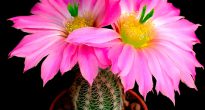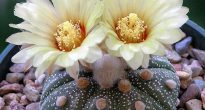The Rebutia plant is part of the Cactaceae family. According to information taken from various sources, this genus unites from 40 to 100 species and even more. Under natural conditions, this plant can be found in Peru, Argentina and Bolivia. Rebutia is very popular with flower growers, since it is undemanding to growing conditions and care, and is not very large. Also, this plant forms many children and can bloom in various conditions.
Rebutia is the closest relative of the Ailostera, which is also part of the same family and is widely cultivated indoors. These plants are very similar to each other. That is why in 2001 the genus Ailoster was included in the genus Rebucius. However, even today there are specialists who are against this merger, in this regard, the final decision has not yet been made, since there are still some difficulties. But for flower growers this is not very important, since the care of these plants is absolutely the same.
Content
- 1 Brief description of cultivation
- 2 Features of rebution
- 3 Rebution care at home
- 4 Reproduction of rebutia
- 5 Pests and diseases of rebutia
- 6 Rebution types with photos and names
- 6.1 Tiny rebutia (Rebutia minuscula), or minusculum rebutia
- 6.2 Rebutia marsoneri
- 6.3 Dwarf rebutia (Rebutia pygmaea)
- 6.4 Rebutia albiflora or white-flowered rebutia
- 6.5 Rebutia canigueralii
- 6.6 Rebutia fulviseta
- 6.7 Rebutia krainziana
- 6.8 Rebutia perplexa
- 6.9 Rebutia pulvinosa
- 6.10 Rebutia deminuta
- 6.11 Rebutia solar (Rebutia heliosa)
- 6.12 Rebutia chrysacantha
- 6.13 Rebutia fiebrigii
- 6.14 Rebutia muscula
Brief description of cultivation
- Bloom... If optimal conditions for growth are created for rebutia, then from the second year of life its flowering will last all year round. However, the laying of flower buds occurs in the last days of February.
- Illumination... The plant needs bright light of the sun all year round, which is why a sill with a southern orientation is most suitable for it.
- Temperature regime... During active growth, the bush should be at normal room temperature. In winter, the cactus is transferred to a cooler place (from 8 to 12 degrees).
- Watering... It is necessary to moisten the soil mixture in the pot systematically and in moderation. In summer, watering is carried out 1 time in 7 days, however, on hot days, the soil mixture is moistened more often. In winter, the bush is almost never watered, especially if you need to get babies.
- Air humidity... The level of air humidity that is typical for residential premises is well suited.
- Fertilizer... Mineral complex fertilizer for cacti is applied to the substrate 1 time in 30 days from April to September. Before feeding a cactus, it must be watered with clean water.
- Dormant period... Not pronounced. However, it usually lasts 4 to 6 weeks and starts immediately after flowering ends.
- Transfer... It is carried out only if necessary, after the root system becomes very cramped in the pot. The flower is transplanted in March.
- Reproduction... Most often, children are used for this (lateral shoots), but sometimes the seed method is also used.
- Pests... Scabbards, red spider mites and mealybugs.
- Diseases... Cork growths as well as stem rot.
Features of rebution
Ribbed stems of rebutia have an ideal spherical shape, while there are many needles on their surface. As a rule, the stem height is 50–60 mm, but sometimes it can reach up to 100 mm. The low spirally located ribs on the stem are very weakly expressed and divided into tubercles. One stem has at least 11 ribs. Each areola can grow about 30 needles, which are very thin, irregular and outwardly similar to bristles. Both central needles with a length of about 30 mm and radial needles grow up to 5 mm. Since there are a lot of thorns on one stem, it looks like a fluffy ball. Single and rather large glossy funnel-shaped flowers are quite wide open, they can be colored orange-yellow, pinkish-orange, red or orange. As a rule, flowers form in the lower areoles of the lateral surface of the stem, while they form a surrounding wreath. To understand the rebution in front of you or the Aylostera, you need to pay attention to the structure of the flower: the tube of the rebutia is non-accrete and smooth, while the pistil of the Aylostera is ½ part fused with the tube, on the surface of which there is pubescence.
Rebution care at home
It is very easy to care for room rebution. The fact is that this is a mountain plant, and therefore it is distinguished by its undemanding care and growing conditions.
Temperature regime
If you want the bush to bloom regularly and magnificently, then special attention should be paid to its wintering. In winter, it should be cool (from 8 to 12 degrees). When purchasing a cactus in a store, do not forget to ask the seller what is the optimal wintering temperature for this particular plant. The fact is that recently such varieties have appeared, which in winter should be at a temperature of about 5 degrees. You also need to remember that for normal growth, a cactus needs fresh air, and for this the room where the plant is located must be regularly ventilated. Stale air can be very harmful to rebutia, but sharp drops between night and day temperatures are very useful for her. During the growing season, the flower grows well at any temperature.
Illumination
This plant is one of the light-loving, and the direct rays of the sun do not harm it. In this regard, the rebution can be placed on the south window, while you should not worry that it is under the scorching rays of the sun, since the bush will not overheat and burns will not appear on it. When choosing a place for a flower, remember that even a little shading can harm it.
Watering
Rebutia, unlike many other cacti, normally reacts to a small and infrequent waterlogging of the soil mixture in a pot. But try to keep this happening as little as possible. It is necessary to water the cactus in a timely manner and with a sufficient amount of water, while the frequency and abundance of watering is affected by the rate of evaporation of moisture from the substrate, as well as the air temperature in the room. In the summer, it is quite enough to water the cactus only 1 time in 7 of it.However, on hot days, it is recommended to increase the frequency of watering.
In winter, the frequency of watering also depends on the air temperature and the rate of evaporation of liquid from the soil mixture. It should be borne in mind that in winter, the bush is cool and moisture in such conditions evaporates from the substrate more slowly. That is why watering at this time is very rare and uses a small amount of water for this. If the wintering of the rebutia takes place in a warm place, or children grow on it, which reach no more than 30 mm in diameter, it also needs to be watered infrequently and with a small amount of water.
Remember not to stress the cactus, the abundance and frequency of watering should be reduced or increased gradually. For irrigation, you should use water that has settled well for at least 24 hours, which, moreover, should be slightly warm (the temperature is 2 degrees above room temperature).
It is not necessary to moisten the bush with a sprayer or arrange a shower. If dust has accumulated on its surface, then a soft bristled brush is used to remove it.
Top dressing
Such a cactus does not need feeding at all. However, if you want the flowering to be long and lush, then feed it from April to September once every 30 days. To do this, use a complex mineral fertilizer for cacti, and its solution should be unconcentrated. Remember that before you start feeding, the plant must be watered.
Rebution transplant
The transplant is carried out at the beginning of the growing season, or rather, in March. But such a procedure is necessary only if necessary, when the root system becomes very cramped in the pot. Rebutia grows best in ready-made soil mix for cactus and succulent plants, which can be purchased at specialty stores. It is lightweight, water permeable, sand-based and contains gravel.
Immediately before transplanting, the flower does not need to be watered, while the earthen lump in the pot should dry out completely. Make a good drainage layer on the bottom of the new container. Then carefully transfer the bush into a new container from the old one, and fill all the voids with a new substrate, which should be dry. Move the transplanted shrub to a well-lit and warm place. The first time you need to water the cactus after transplanting is only after 7 days. And for another two to three months, be extremely careful with watering.
Bloom
Both Ailostera and Rebutia begin to bloom at 2-3 years of age. As a rule, flowers on a bush are formed in the summer. The opening of flowers occurs only on sunny days, and with the onset of the evening they close. The minimum lifespan of one flower is two days.
If you care for the plant correctly, and it refuses to bloom, then the reason may be as follows:
- the bush does not have enough sunlight, because throughout the year it needs bright light;
- improper wintering, the flower in the cold season should be at a temperature of about 10 degrees;
- unsuitable soil mixture, which must pass water and air well;
- the wrong watering regime: in the summer, the bush needs moderate moisture, in the autumn months it is poor, and in winter it is better not to water it at all.


Watch this video on YouTube
Reproduction of rebutia
The rebutia has many lateral processes with which it can be easily propagated. To do this, separate the baby from the bush and plant it in a loose and light soil mixture, where it should give roots. These babies are very fast growing, and pretty soon new babies are formed on them.
The seed method can also be used to propagate this plant. First, the seeds are immersed in a pinkish potassium manganese solution for 10 minutes for disinfection, and then they are left in the open air to dry.Seed material is sown at the very beginning of spring, using low, but wide bowls for this, which are filled with soil mixture, combined with sand or with stone granules. When sowing, a distance of 20-30 mm is observed between the seeds, in this case, in the future, young bushes will not need a pick. For growing young bushes, a temperature of 15 to 20 degrees is ideal, but do not forget to water and air them in a timely manner. When the seedlings grow a little and get stronger, they are planted in individual small pots.
Young bushes need plenty of bright light throughout the year. That is why it is recommended to supplement them in winter during the first two years of life.
Pests and diseases of rebutia
Diseases
Cork formations can form on rebution. As a rule, they appear due to the fact that the bush was exposed to too low air temperatures, it was damaged mechanically, or it was watered too poorly in the warm season.
At the same time, sometimes stem rot develops on the plant, this happens if it is watered during the dormant period. A rotten bush is stopped watering and waited for its stem to dry out.
Rot can also form on the root system of a plant. As a rule, this is due to the fact that a lot of nitrogen was introduced into the substrate or it was not introduced in time.
Pests
This cactus is quite resistant to pests, but sometimes scale insects, red spider mites or mealybugs can still settle on it. If scale insects or scale insects were found on the bush, then first you need to try to remove all individuals from it. To do this, use a cotton swab, which is moistened with alcohol. Then the plant is treated with a solution of Fitoverm or Actellik. These chemicals are also used in the fight against ticks. For prophylactic purposes, frequent examination is recommended, as well as wiping with a brush moistened with alcohol.
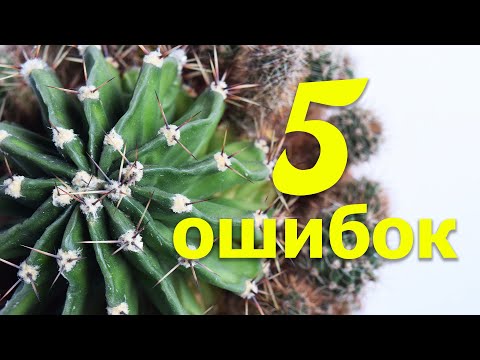

Watch this video on YouTube
Rebution types with photos and names
The most popular among flower growers are those types and varieties of rebuts that bloom brightly and very luxuriantly.
Tiny rebutia (Rebutia minuscula), or minusculum rebutia
This miniature cactus is highly decorative. The shape of the stem is spherical and flattened, and it reaches about 50 mm in diameter. On the surface of the ribs there are spirally located tubercles, and about 30 white needles grow in each of the areoles. Crimson or deep red flowers are quite large. And when the bush fades, small berries of a pale red hue form on it.
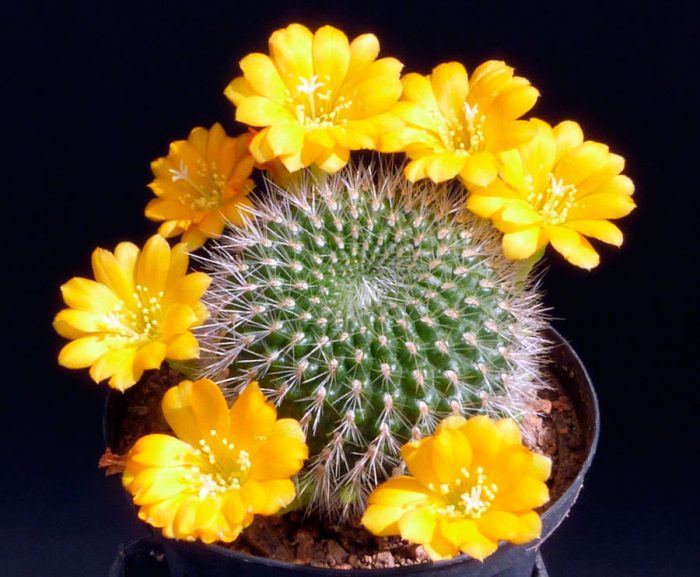

This species has a variety - senile rebutia (Rebutia senilis)... Once this cactus was isolated as a separate species. It comes from northern Argentina, its stem reaches about 80 mm in height and up to 70 mm in diameter. On the surface of the bush, snow-white bristles-thorns are formed, reaching about 30 mm in length. At the beginning of the spring period, red flowers appear on it with a center of white tint, which reach about 30 mm in diameter.
Rebutia marsoneri
This look is also pretty effective. In spring, flowers of a deep yellow color are formed on the bush, the middle of which is of a darker shade. The stems of the bush are narrow and ball-shaped, most often they grow together and form a dense bunch, the surface of which is covered with numerous white soft and dark hard needles.
Dwarf rebutia (Rebutia pygmaea)
The stem has an oval or cylindrical shape, as a rule, its height is no more than 40 mm. The entire surface of the bush is covered with numerous needles. A lot of children are formed on it, which have their own roots. This cactus has a spectacular flowering.Tubular flowers bloom around its base, distinguished by their elegance, they can be painted in a pale pink or red hue.
Rebutia albiflora or white-flowered rebutia
This cactus forms a dense curtain, which consists of many balls, reaching about 20 mm in diameter. They are covered with many soft, villous-like needles, making the stems appear whitish in color. Cream-colored flowers have a pale pink edge of pointed petals. In diameter, these flowers reach 40 mm.
Rebutia canigueralii
This cactus is very drought tolerant. Its not very large stem has the shape of a ball. Its surface is covered with very long needles that are quite tough. During flowering, a wreath of small bell-shaped flowers forms at the top of the stem. Their whitish petals have pale blue edging, and they also have yellow stamens that stick out in a bunch.
Rebutia fulviseta
The stem of this cactus is in the shape of a ball, and it is painted in a dark green hue, and under certain lighting it may seem that it has a black color. The surface of the stem is covered with many strong brown needles. During flowering, beautiful, not very large flowers of a deep red or carrot shade appear on the bush.
Rebutia krainziana
This species grows extremely rarely and, as a rule, it is a large stem shaped like a ball. The surface of the stem is covered with many white tubercles, from which white short needles grow. The petals of the deep red small flowers are swirling. The flowers themselves are formed at one point on the stem, and not in a circle.
Rebutia perplexa
The surface of the strongly branching fleshy stem is covered with smooth tubercles. This species has very few needles. The flowers are usually pinkish, but can also be fuchsia, which is uncommon for rebutia.
Rebutia pulvinosa
The spherical stem has a relief surface, which is covered with calibrated tubercles, with short, very hard brown needles sticking out of them. During flowering, a wreath of small flowers, colored in a deep orange or red, forms around the stem.
Rebutia deminuta
The homeland of this species is Argentina. The low stem has a spherical shape, it is covered with many strong brown needles. Flowering occurs in the first summer weeks, and the bush at this time is decorated with flowers of a deep red or orange hue.
Rebutia solar (Rebutia heliosa)
A very interesting cactus. It has a very small stem and large flowers that rise on long stalks, making them appear gigantic.
Rebutia chrysacantha
This cactus differs from the rest by its golden-orange flowers and yellowish needles.
Rebutia fiebrigii
This type is quite effective. The fact is that during flowering, rich orange flowers stand out brightly against the background of whitish needles.
Rebutia muscula
As a rule, the bush has several stems, which are small spiny balls, which reach about 50 mm in diameter. Their surface is strewn with many needles of light color, due to which they look like mice. Flowers bloom only in the daytime, and in diameter they can reach up to 50 mm. The flowers have a long tube and are orange in color.

